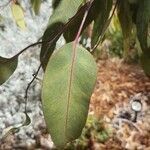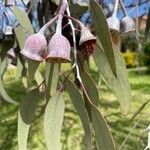Mallee to 10 m. Adult leaves: lamina 15–24 cm long, 2.5–5 cm wide, acuminate; lateral veins faint, at 35°–45°; intramarginal vein almost confluent with margin; petiole 2–6 cm long. Peduncle terete, pendulous, 30–45 mm long; pedicels 10–33 mm long. Operculum 16–22 mm long, 20–25 mm wide; hypanthium obconical, 10–20 mm long, 20–25 mm wide. Fruits campanulate, 25–37 mm long, 25–40 mm wide.
A weeping tree. The branches hang down. It grows 4-10 m high and spreads 2.5-8 m across. The bark is reddish-brown and peels off in red layers revealing a powdery white stem. The stems, buds and capsules have a white powdery appearance. The leaves are grey and hang down. The flowers are pink. They hang in clusters. The flowers are 5 cm across. The fruit is urn shaped and 5 cm long.
Mallee to 10 m. Adult leaves: lamina 7–12 cm long, 1.2–2.5 cm wide, acute or acuminate; lateral veins faint, at 30°–40°; intramarginal vein faint, almost confluent with margin; petiole 1–4 cm long. Peduncle terete, 20–30 mm long; pedicels 10–30 mm long. Operculum 8–10 mm long, 10–12 mm wide; hypanthium 8–12 mm long, 10–12 mm wide. Fruits urceolate, 20–30 mm long, 18–25 mm wide.



